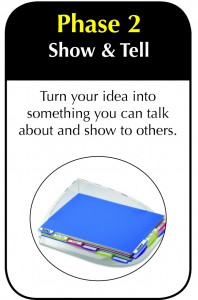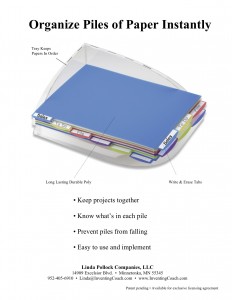
Show & Tell = Turn your idea into something you can talk about and show to others. You get to:
1. Build a prototype
2. Write cool things about it
3. Make an ad (Sell Sheet)
4. Legally protect it
1. BUILD IT = Make a Prototype
How fun is this? You get to build an example of your idea! It’s called a prototype. The three kinds of prototypes you need to know about are:
- Concept Prototype
- Working Prototype
- Final Prototype
What’s a concept prototype?
Have you ever seen a model of a building before they built it? That’s a concept prototype. It shows what your idea is and supposed to look like, but you can’t really use it. Sometimes concept prototypes only exist as a 3D model in a computer.
What’s a working prototype?
You want to make sure your invention works, right? Build a working prototype and try it out! See what works and what you need to change. Add or subtract pieces and parts. Try new ideas. Be creative. Make mistakes. Your working prototype won’t look like what you’d see in the store. It might even look really ugly! But does it work? That’s the goal. Once you know what works, you can make a nicer looking one if you want, but you don’t always have to make one.
What’s a final prototype?
Wouldn’t it be awful if you had tons of your product built then found a great big mistake with it? That’s why you have a final or pre-production prototype made. The company who makes your product makes the final prototype. It’s your last chance to make sure everything is right before a whole bunch of your products get made. It’ll be built on the same machines that make your real product and should be exactly the same as what you’d buy in the store or online.
Which kind of prototype do I need to make?
Most inventors build a working prototype to test their ideas, and it’s fun to do too! Usually you can build it out of things from around the house or what you can find in a store. Sometimes inventors only make concept models, but that’s when they know the idea will work or there is no way for them to actually build it. If you really rock at making 3D models on the computer, maybe you’ll make both. The inventor doesn’t make the final prototype. It’s made by the company who makes the products that are sold online or in the store.
2. TELL ABOUT IT = Benefit and Feature Statements
Are you excited to tell others about your product? What will you say? It’s important to think it through so others easily understand what your invention is and does. To start, you’ll need to know the difference between a benefit and a feature.
What’s a benefit?
A benefit tells what your product will do for someone:
• Does it solve a problem?
• Can you use it to make money?
• Will it save you money?
• Does it give you more time to do what you want?
• Does it make you look better?
• Will you feel better if you use it?
• Is it fun?
Benefit statement examples: Tastes great; Cut your chore time in half; Keeps you organized; Look fabulous; Fun for the whole family.
Do you notice that benefits can describe many products? Fun for the whole family – Is it a game? A trip? A puppy-dog? Benefits tell why you’d want a product and what it will do for you. It might not tell you anything at all about the product itself.
What’s a feature?
Features describe the actual product:
• What is it?
• What does it look like?
• How does it work?
• How do you use it?
• What is made of?
• What size, shape or color is it?
• What are some other details about it?
Let’s describe the features the game Trouble® as an example:
• It’s a game
• Four people can play
• Each person chooses one color to be his or her peg color: Red, Yellow, Green or Blue
• The game is played on a plastic board with circles sticking up and the circles hold pegs
• There is a dice in the middle of a clear plastic bubble on the board
• Push the bubble to roll the dice and it will tell you how many spaces to move
• You win when you are the first person to get all four of your pegs in the “Finish” row
See how features are very specific and tell you about the actual game itself? You can picture it in your mind when you hear the features. If we were talking about the game Apples to Apples®, all the features would be different except the one saying it’s a game. Features describe your actual invention, what it is and how it works.
Why do I need to know the difference between a benefit and feature?
You want someone to be interested in your idea, right? Tell them what your invention will do for them to get them excited about it. Say, “I’ve invented a product that (then say a benefit). If they want to know more, you can tell them the features. Some people will want to know more and others won’t. When you make your ad (sell sheet), it’ll need both benefits and features on it.
3. SHOW IT = Make a Sell Sheet
Ever see a billboard? What do you look at first? The picture? Then the headline? A sell sheet is a like a billboard. It’s a one-page ad of your invention and its job is to get someone’s attention. The picture on the sell sheet shows what your invention is and does and the headline is a benefit statement. Add a few more benefit and feature statements and your contact information on the sell sheet and that’s it. Include the words “patent pending” if you have filed for patent protection.
Can I make a video?
Of course! Most companies prefer videos along with a sell sheet. Make sure it includes all the same things as a sell sheet: Great visuals of your product, benefits and features and your contact information. Keep it short and to the point.
Do I have to make a video?
No, but videos are great if you have an invention that needs to be seen in action. Sell sheets can work for a product where you can look at a photo and think, “That’s cool. I get it.”
Why do I need an ad (sell sheet) anyway?
So you can show and tell others about your invention. When you are talking with companies about making your invention, don’t give them the prototype, especially if you only have one prototype. Send them a sell sheet instead.
4. PROTECT IT = Intellectual Property (IP)
There are tons of awesome ideas out there and it’s important to protect the ideas you come up with. So what’s intellectual property and why is it important?
Intellectual = From the mind
Property = Something you own and can sell
Intellectual Property (IP) = Something from the mind you can own and sell. It’s all about money! That’s why you want to protect your IP.
What kinds of IP are there?
• Patents keep others from making your invention (Inventions are things or a specific way/process for doing something)
• Copyrights protect how you say or show something (songs, books, art, photography…)
• Trademarks identify products and services. Think brand identities. (McDonalds®, Pepsi®, Subway®)
• Trade Secrets are secrets that only the company knows for making their product, like the KFC® chicken recipe
What do I have to do to protect my ideas?
File forms with the United States Patent and Trademark Office (USPTO) or with the Library of Congress.
Do I have to protect my ideas?
It depends on the idea! If it is something that hasn’t been made or done before then it’s probably best to file for patents. If your idea is a small improvement or something that will only be sold for a very short time, maybe not. Talk an attorney to see what’s right for you.
Do I have to have a patent to make money?
No. Sometimes you file for a patent and don’t get one but you can still sell your product. New toys and fashions rarely have patents.
Is getting a patent the first step?
No. First Investigate to see who makes similar products and check that you aren’t taking someone else’s idea. Then build your prototype, write about it and make your sell sheet/ad. Once that’s done, then you can file for protection, but sometimes you’ll file a Provisional Patent Application (PPA) instead.
How do I find out more about patents?
Talk with a patent attorney, look at the free resources for inventors at the USPTO, attend local inventor groups and there are also wonderful books like David Pressman’s, Patent It Yourself (Nolo Press).

